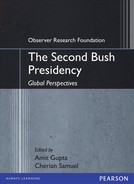Chapter 1
1 Secretary of State, Condoleeza Rice, “Remarks en route to India,” Department of State press release available at, http://www.state.gov/secretary/rrn/2005/43465.htm
2 See, Background Briefing by Administration Officials on US-South Asia Relations, Department of State, March 25, 2005, available at, http://www.state.gov/r/pa/prs/ps/2005/43853.htm
3 Michael Sirak, “US signs defence pact with India, Jane’s Defence Weekly, 13 July 2005, p. 15.
4 The best discussion of the assumptions, motivations, and style of India’s foreign policy is provided in Sisir Gupta 1964, India and Regional Integration in Asia, pp. 1–27.
5 For a discussion of the restrictive nature of Indian arms transfer policies see Amit Gupta, “I want my M-i-G: How India’s Force Structure and Military Doctrine are Determined,” Asian Survey, Vol. XXXV, No. 5, May 1995, pp. 441–58.
6 Speech to the Brookings Institution, Washington, D.C., September 9, 2002.
7 Amit Gupta, The US-India Relationship: Strategic Partnership or Complementary Interests,” Strategic Studies Institute Monograph, US Army War College, Carlisle Barracks, Pennsylvania, February 2005, p. 16.
8 The definition of first, second, and third tier nuclear states and the implications for state behaviour is discussed in Amit Gupta, “N plus 20? India’s Third Tier Nuclear State Dilemma,” Asian Survey, Vol. XLI, No. 10, November/December 2001, pp. 1054–55.
9 There are, of course, exceptions to the idea of deterrence. North Korea may have a deterrent capability against the United States because it has the capacity to destroy Seoul and to kill thousands of US soldiers based in South Korea. While not threatening the United States homeland with acceptable damage, Pyongyang still has a deterrent capability that prevents a US invasion.
10 Sisir Gupta, “The Indian Dilemma,” in Alastair Buchan (ed.) A World of Nuclear Powers?, 1966 pp. 58–60.
11 “Seal Scorpene deal fast: Navy chief,” The Times of India, August 12, 2004.
12 Ashley J. Tellis, “The Strategic Implications of a Nuclear India.” Orbis, Vol. 26, No. 1, Winter, 2002, pp. 13–45.
13 For a recent discussion of the different problems associated with securing the Pakistani nuclear weapons see Graham Allison, “Tick, Tick, Tick,” The Atlantic Monthly, Volume 294, Issue 3, October 2004, p.60.
14 Indian analysts have exaggerated the number of weapons needed to deliver a second strike against Pakistan. Pakistan has three major cities and their destruction would essentially destroy the country’s industrial and administrative capability.
15 Ashley J. Tellis, 2001 India’s Emerging Nuclear Posture: Between Recessed Deterrence and Ready Arsenal, p. 61.
16 Amit Gupta, “Fire in the Sky: The Indian Missile Program,” Defence and Diplomacy, October 1990.
17 For a discussion of India’s strategic perspectives and its perceived role in Asia see the address by the Indian Defence Minister, Mr. Pranab Mukherjee to the Carnegie Endowment for International Peace. Address by the Defence Minister Pranab Mukherjee at the Carnegie Endowment for International Peace, Washington, DC on India’s Strategic Perspectives. Washington, DC, June 27, 2005. Available at, http://www.carnegieendowment.org/files/Mukherjee_Speech_06-27-051.pdf
18 “India will never succumb to terror in J&K: PM,” The Hindustan Times, September 16, 2005.
19 “Navy prefers F-35s to F-18s,” The Hindu, July 12, 2005.
20 C. Raja Mohan, “What If Pakistan Fails? India Isn’t Worried… Yet,” The Washington Quarterly, Vol. 28, No. 1, Winter 2004–2005, p. 127.
21 “No redrawing of borders but other possibilities: Manmohan,” The Hindustan Times, September 11, 2005.
22 Thomas Donnelly and Melissa Wisner, 2005 “A Global Partnership between the US and India,” American Enterprise Institute Short Publication, August–September 2005, p. 3.
23 “The India Imperative: A Conversation with Robert Blackwill,” The National Interest, Summer 2005, p. 13.
24 Rahul Bedi, “Power Play,” Jane’s Defence Weekly, 13 July 2005, p. 25.
25 Ashley Tellis, “India as a New Global Power: An Action Agenda for the United States,” Washington D.C.: Carnegi Endowment for International Peace Report 2005, p. 50.
26 “Foreign students diminishing in Indian universities,” The Hindustan Times, February 9, 2004.
27 See, “Indigenous Technology Development: A holistic view,” IIT Kharagpur website, available at, http://www.iitkgp.ernet.in/acad_n_res_fac/cet/cal.php
28 N. Gopal Raj, A satellite to serve students, The Hindu, September 22, 2004.
29 For a discussion of this alternative approach see Amit Gupta, 2005 Dealing with the United States: A Proactive Policy for India, pp. 39–47.
